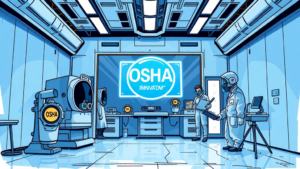Master EU GMP Annex 1 Gowning for 2025 Audits

As the pharmaceutical industry gears up for the 2025 EU GMP Annex 1 updates, compliance managers face new challenges in implementing Grade A monitoring requirements. This guide provides actionable insights to streamline audit preparation and ensure seamless compliance with the latest regulations.

Understanding EU GMP Annex 1 Gowning Requirements
The latest updates to EU GMP Annex 1 have brought significant changes to gowning protocols and Grade A monitoring standards. These revisions aim to enhance sterility assurance and minimize contamination risks in pharmaceutical manufacturing environments.
Key updates include:
- Stricter gowning procedures for Grade A and B areas
- Enhanced monitoring of particulate and microbial contamination
- Increased focus on risk assessment and management
- More stringent requirements for cleanroom design and maintenance
Compliance managers must familiarize themselves with these changes to ensure their facilities meet the new standards. For a comprehensive overview of EU GMP resources, visit our dedicated page.

Steps to Implement Grade A Monitoring
Implementing Grade A monitoring requires a systematic approach. Follow these steps to ensure compliance with EU GMP Annex 1:
- Assess Current Practices: Evaluate existing gowning procedures and monitoring systems against the new requirements.
- Upgrade Equipment: Invest in state-of-the-art monitoring equipment capable of real-time particulate and microbial detection.
- Develop SOPs: Create detailed Standard Operating Procedures (SOPs) for gowning, monitoring, and data management.
- Train Personnel: Conduct comprehensive training sessions for all staff involved in cleanroom operations.
- Implement Documentation Systems: Establish robust documentation processes to track gowning compliance and monitoring results.
- Conduct Regular Audits: Perform internal audits to identify and address potential compliance gaps.
- Continuous Improvement: Regularly review and update procedures based on monitoring data and industry best practices.

Common Challenges in Gowning Compliance
Achieving and maintaining gowning compliance can be challenging. Here are some common pain points and strategies to overcome them:
- Staff Training: Develop interactive training programs and use visual aids to reinforce proper gowning techniques.
- Contamination Risks: Implement advanced airlock systems and conduct regular environmental monitoring to minimize contamination.
- Documentation Burden: Utilize digital solutions to streamline documentation processes and ensure data integrity.
- Maintaining Consistency: Establish clear protocols and conduct regular refresher training to maintain consistent gowning practices.
- Adapting to New Technologies: Stay informed about emerging technologies in cleanroom monitoring and gowning materials to continuously improve compliance efforts.
Best Practices for Audit Preparation
Preparing for EU GMP audits requires meticulous planning and execution. Consider these proven strategies:
- Develop Comprehensive Checklists: Create detailed checklists covering all aspects of EU GMP Annex 1 compliance, with a focus on gowning and Grade A monitoring.
- Conduct Mock Audits: Regularly perform mock audits to identify and address potential compliance gaps before official inspections.
- Review and Update Documentation: Ensure all SOPs, training records, and monitoring data are up-to-date and easily accessible.
- Engage Staff: Involve all relevant personnel in audit preparation, fostering a culture of compliance throughout the organization.
- Implement Continuous Improvement: Establish a system for ongoing review and improvement of gowning and monitoring practices based on audit findings and industry developments.
- Leverage Technology: Utilize compliance management software to track audit preparation progress and manage documentation efficiently.
- Seek Expert Consultation: Consider engaging regulatory experts to provide insights and guidance on audit preparation strategies.
Case Study: Achieving EU GMP Annex 1 Compliance Ahead of Schedule
A leading European pharmaceutical company, facing the challenge of meeting the new EU GMP Annex 1 requirements, implemented a proactive compliance strategy. By focusing on early adoption of Grade A monitoring technologies and comprehensive staff training, they achieved full compliance well ahead of the 2025 deadline.
Key success factors included:
- Early investment in advanced particulate monitoring systems
- Development of a digital training platform for gowning procedures
- Implementation of a risk-based approach to cleanroom management
- Regular mock audits and continuous improvement initiatives
As a result, the company not only met regulatory requirements but also saw improvements in product quality and operational efficiency.
よくある質問
What are the key changes in EU GMP Annex 1 for 2025?
The 2025 updates focus on enhanced sterility assurance, including stricter gowning protocols, more rigorous environmental monitoring, and a greater emphasis on risk management in cleanroom operations.
How can I ensure my facility meets Grade A monitoring requirements?
Implement state-of-the-art monitoring systems, develop comprehensive SOPs, provide thorough staff training, and conduct regular internal audits to ensure compliance with Grade A monitoring standards.
Common findings include inadequate gowning procedures, insufficient staff training, poor documentation of gowning practices, and failure to properly maintain gowning areas.
How often should gowning protocols be reviewed and updated?
Gowning protocols should be reviewed at least annually or whenever significant changes occur in regulations, technologies, or facility operations. Regular reviews ensure ongoing compliance and opportunities for improvement.
結論
Mastering EU GMP Annex 1 gowning requirements for 2025 audits requires a proactive approach, attention to detail, and a commitment to continuous improvement. By understanding the latest regulatory updates, implementing robust Grade A monitoring systems, addressing common compliance challenges, and following best practices for audit preparation, pharmaceutical companies can ensure they meet and exceed regulatory expectations.
As the deadline approaches, now is the time to assess your current practices and take decisive action to enhance your gowning and monitoring protocols. Remember, compliance is not just about meeting standards—it’s about fostering a culture of quality and safety that benefits your organization and patients alike.
Ready to elevate your EU GMP Annex 1 compliance strategy? Book a Regulatory Consultation with our experts today and ensure your facility is audit-ready for 2025 and beyond.








